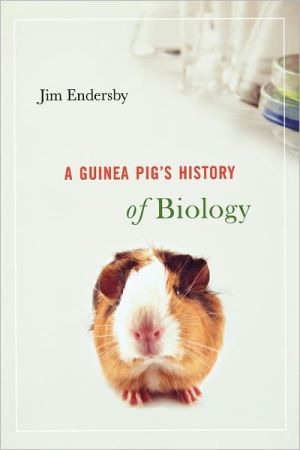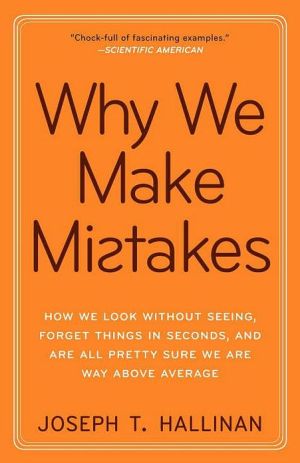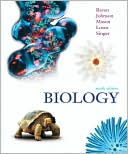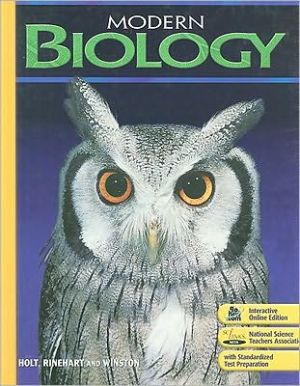A Guinea Pig's History of Biology
"Endless forms most beautiful and most wonderful have been, and are being, evolved," Darwin famously concluded The Origin of Species, and for confirmation we look to...the guinea pig? How this curious creature and others as humble (and as fast-breeding) have helped unlock the mystery of inheritance is the unlikely story Jim Endersby tells in this book.\ Biology today promises everything from better foods or cures for common diseases to the alarming prospect of redesigning life itself. Looking...
Search in google:
"Endless forms most beautiful and most wonderful have been, and are being, evolved," Darwin famously concluded The Origin of Species, and for confirmation we look to...the guinea pig? How this curious creature and others as humble (and as fast-breeding) have helped unlock the mystery of inheritance is the unlikely story Jim Endersby tells in this book.Biology today promises everything from better foods or cures for common diseases to the alarming prospect of redesigning life itself. Looking at the organisms that have made all this possible gives us a new way of understanding how we got here—and perhaps of thinking about where we're going. Instead of a history of which great scientists had which great ideas, this story of passionflowers and hawkweeds, of zebra fish and viruses, offers a bird's (or rodent's) eye view of the work that makes science possible.Mixing the celebrities of genetics, like the fruit fly, with forgotten players such as the evening primrose, the book follows the unfolding history of biological inheritance from Aristotle's search for the "universal, absolute truth of fishiness" to the apparently absurd speculations of eighteenth-century natural philosophers to the spectacular findings of our day—which may prove to be the absurdities of tomorrow.The result is a quirky, enlightening, and thoroughly engaging perspective on the history of heredity and genetics, tracing the slow, uncertain path—complete with entertaining diversions and dead ends—that led us from the ancient world's understanding of inheritance to modern genetics. The Barnes & Noble Review The incredible intellectual journey from Charles Darwin's first experiments with orchids and passionflowers -- starting in 1854 as he sought to unriddle the elements of heredity -- to the patenting of the world first transgenic animal, OncoMouse, in 1988, is an intense and exciting voyage of discovery whose fascinating zigzags, cul-de-sacs, and milestones have seldom been charted in a more entertaining fashion than in Jim Endersby's A Guinea Pig's History of Biology. Endersby's unique narrative hook is to organize his chapters around some previously unsung "heroes": the various humble plants, animals, and microbes that have been the focus of innumerable scientific investigations into the secrets of genetics, and which have generously, although sometimes grudgingly, yielded their secrets to a small army of master, journeyman, and apprentice researchers, all of whom emerge as vivid personalities through his lucid prose. This authorial conceit provides a sturdy armature on which to affix everything from biography to cultural analysis to literary exegesis to sociopolitical musings, but Endersby never allows his hook to interfere with a good anecdote or a brilliant schematic of the way science and biology really work. Combining the same taste for eccentrics and oddities associated with historian of magic Ricky Jay with the rationalist, layman-favoring clarity of biologist Stephen Jay Gould, Endersby does honor to the quagga, the zebrafish, the mouse-ear cress, the fruit fly, and a handful of other species. Like James Burke in his show Connections, Endersby startles with his account of historical serendipity that ultimately proves almost magically inevitable. --Paul DiFilippo
Preface and acknowledgements ix1 Equus quagga and Lord Morton's mare 12 Passiflora gracilis: Inside Darwin's greenhouse 293 Homo sapiens: Francis Galton's fairground attraction 614 Hieracium auricula: What Mendel did next 955 Oenothera lamarckiana: Hugo de Vries led up the primrose path 1286 Drosophila melanogaster: Bananas, bottles and Bolsheviks 1707 Cavia porcellus: Mathematical guinea pigs 2098 Bacteriophage: The virus that revealed DNA 2519 Zea mays: Incorrigible corn 29210 Arabidopsis thaliana: A fruit fly for the botanists 33411 Danio rerio: Seeing through zebrafish 37312 OncoMouse®: Engineering organisms 411Bibliography, sources and notes 433Index 483
\ Daily MailJim Endersby's book is packed with strange lore about the creatures that live in laboratories, but it is no mere miscellany. He has hit upon the bright idea of telling the story of reproduction, inheritance and evolution—and how we learnt about them, by focusing on the handful of creatures that have provided most of our knowledge: the fruitfly, the zebrafish, the bacteriophage, Darwin's passion flowers, maize, the evening primrose, the cress plant Arabidopsis and a few others. Oh, and not forgetting Homo sapiens. Endersby's technique is a wonderfully roundabout way of telling some of the great stories of modern biology.\ — Peter Forbes\ \ \ \ \ \ Sunday TelegraphOver the past two decades, dozens of popular books discussing the Darwinian perspective on the history of biology have appeared, many of them derivative and stale. Some of us are feeling rather Darwinned out. But Jim Endersby has come up with a fresh and rewarding approach. He illuminates the story of our understanding of life since 1800 (when the word biology was coined) by focusing on 12 organisms that have been most useful to natural scientists in illuminating one of life's central mysteries, inheritance. The result is a hefty, easily readable account of the remarkable progress biologists have made over the past two centuries to enrich our understanding of life...Much of the charm of Endersby's account derives from his meandering style and his eye for the telling incident...Endersby's account of how zebra fish became one of nature's most revealing organisms is a gem of popular science writing, both an entertainment and an education. It demonstrates that a talented historian can illuminate science that has come to appear jaded after too many retellings by authors with a meagre grasp of their subject's past.\ — Graham Farmelo\ \ \ \ The GuardianBy telling the laboratory life-stories of Passiflora, Oenothera, Drosophila, Arabidopsis and Danio, as well as the trusty Cavia porcellus and one or two others, the historian Jim Endersby reveals how humans have unravelled the mysteries of evolution, genetics and development to such an extent that we can now, up to a point, engineer life itself...Endersby introduces us to many more names, less famous but each a crucial contributor to modern biology. Through their stories he explodes the persistent myth that science is a series of eureka moments by heroic individuals, instead revealing a complex reality of social interaction and interdependence...An account that draws much of its fascination from unexpected connections. With an enviable lightness of touch, Endersby weaves his scientific threads into a much broader tapestry of cultural history...Accessible and engaging.\ — Georgina Ferry\ \ \ \ \ \ New ScientistTry to skim this book and you'll find yourself drawn into reading every word. Eye-opening and entertaining, this is cutting-edge history of science that everyone should read. Discover why Charles Darwin puzzled over passion flowers, and how the most unlikely of experimental organisms—from guinea pigs to an unprepossessing cress plant—contributed to what are now hailed as landmark discoveries, as well as leading to a lot of dead ends. Throughout his gripping narrative, Jim Endersby shows how today's right answer is almost always tomorrow's wrong one.\ — Gail Vines\ \ \ \ \ \ Sunday TimesA highly entertaining and original book. Science is a collaborative process and by looking at the roles played by unwilling collaborators, from guinea pigs to zebrafish, Endersby provides a new perspective on the history of genetics.\ — Nick Rennison\ \ \ \ \ \ The IndependentEndersby, a young historian of science, has had the neat idea of telling the stories of the creatures which became the emblems of the modern lab. It offers an unusual viewpoint on the path from natural history, which grew from observing living things in the wild, to the biological laboratory...Endersby's engaging book covers a good range of the most important lab beasts, and chooses its stories well. It is an absorbing tale of the way our understanding of genetics has depended on a crucial set of involuntary collaborators, the unsung heroes of the laboratory.\ — Jon Turney\ \ \ \ \ \ ScienceCharming...The book offers lay readers an engaging and lively introduction to the history of biology.\ — Vassiliki Betty Smocovitis\ \ \ \ \ \ ChoiceEndersby provides a delightfully told history primarily of genetic biological research.\ — A. B. Schlesinger\ \ \ \ \ \ Science Books & FilmsIn many ways this book is so much more than the title suggests. The text portrays the development not only of genetics, but also of biochemistry, developmental biology, and physiology, as well as chemistry and physics. Furthermore, in a very readable style, the author recounts many periods in history, not just providing a look at science through the years, but also exploring political, economic, and social issues and showing how intimately science and scientists connect with, and are influenced by, other social trends. This book would be of interest to anyone fascinated or intrigued by genetics or biological research, as well as any professional or lay student of history and science.\ — Amy Hark\ \ \ \ \ \ DiscoveryI completely enjoyed reading this historical account of the progression of molecular biology over the past two centuries. Dry and dull\ “geek-speak”? Hardly. It reads like a work of fiction, complete with fascinating narratives and quirky bits of detail. Clearly the author put a great deal of effort into thoroughly investigating and communicating both the scientific and human sides of this topic...Dr. Endersby does a fascinating job of connecting society and science in this historical account of scientific progress over the last 200 years. He underlines the fact that no matter how objective scientists may try to be, they are working within social and political environments that are guiding their thought processes whether they realize it or not.\ — Wendy Tymchuk\ \ \ \ \ \ Buffalo NewsI cannot imagine a finer history of the subject than Jim Endersby's A Guinea Pig's History of Biology. Don't be put off by that title: the book's chapters center on research subjects—Darwin's passionflowers, Mendel's hawkweeds and the horses, fruit flies, corn, zebrafish, mice and, yes, guinea pigs studied by lesser-known scientists. This is simply the best science book accessible to the non-scientist that I have read since Bryson's Short History of Nearly Everything.\ — Gerry Rising\ \ \ \ \ \ Barnes and Noble ReviewThe incredible intellectual journey from Charles Darwin's first experiments with orchids and passionflowers—starting in 1854 as he sought to unriddle the elements of heredity—to the patenting of the world first transgenic animal, OncoMouse, in 1988, is an intense and exciting voyage of discovery whose fascinating zigzags, cul-de-sacs, and milestones have seldom been charted in a more entertaining fashion than in Jim Endersby's A Guinea Pig's History of Biology.\ — Paul DiFilippo\ \ \ \ \ \ New York SunAs Jim Endersby notes in his fascinating A Guinea Pig's History of Biology, progress in biology owes as much to the hawkweed and the humble corncob as it does to the brainstorms of scientists. Mr. Endersby has had the happy idea of tracing the successes of modern biological research through the subjects which have made it possible...In Mr. Endersby's account, the history of modern biology is a story of challenged assumptions, of refusing to accept easy explanations, of a willingness to ask apparently silly questions and to pursue the answers to them with astonishing doggedness...Whether he is discussing Robert Koch and the development of germ theory or the intricacies of Gregor Mendel's lifelong research on the genetics of peas, Mr. Endersby presents an admirably lucid explanation of both the scientific issues at stake and of the human and social factors that influenced the course of the research. In his narrative, the scientists, from the explosive J.B.S. Haldane to the flamboyant Barbara McClintock, come to life in all the grandeur of their genius as well as their quite considerable wackiness. At the same time, he never loses sight of the fact that these remarkable figures worked among a throng of silent and involuntary collaborators. Without the primrose, the guinea pig, the zebra fish, and the ear of corn, even the least of life's secrets might have slipped from our grasp.\ — Eric Ormsby\ \ \ \ \ \ Publishers WeeklyLike all the sciences, biology is rooted in observation, but in order to tease out the principles of reproduction and genetic inheritance, biologists needed to find plants and animals with fast breeding cycles-hence the popularity of guinea pigs, zebra fish and fruit flies as experimental subjects. Endersby's history explains how such life forms have been put to use by scientists from Charles Darwin's age to the present. But the flora and fauna are just a hook for Endersby, a lecturer in history at the University of Sussex, to talk about the scientists, and he's often at his most winning delving into biographical details, like the friendship between science writer Paul de Kruif and Sinclair Lewis, whom de Kruif advised on science and medicine for the novel Arrowsmith. He's also good at spotlighting small events that had sweeping consequences, like the 1847 repeal of a British tax on glass, which led to more greenhouses, which led to an outburst of botanical observation. Later chapters broach hot-button topics like genetically modified food and the backlash against animal testing. Endersby offers a fresh take and surprising conclusions ("Mendel did not invent modern genetics") on familiar material. 12 b&w illus. (Nov.)\ Copyright 2007 Reed Business Information\ \ \ \ \ The Barnes & Noble ReviewThe incredible intellectual journey from Charles Darwin's first experiments with orchids and passionflowers -- starting in 1854 as he sought to unriddle the elements of heredity -- to the patenting of the world first transgenic animal, OncoMouse, in 1988, is an intense and exciting voyage of discovery whose fascinating zigzags, cul-de-sacs, and milestones have seldom been charted in a more entertaining fashion than in Jim Endersby's A Guinea Pig's History of Biology. Endersby's unique narrative hook is to organize his chapters around some previously unsung "heroes": the various humble plants, animals, and microbes that have been the focus of innumerable scientific investigations into the secrets of genetics, and which have generously, although sometimes grudgingly, yielded their secrets to a small army of master, journeyman, and apprentice researchers, all of whom emerge as vivid personalities through his lucid prose. This authorial conceit provides a sturdy armature on which to affix everything from biography to cultural analysis to literary exegesis to sociopolitical musings, but Endersby never allows his hook to interfere with a good anecdote or a brilliant schematic of the way science and biology really work. Combining the same taste for eccentrics and oddities associated with historian of magic Ricky Jay with the rationalist, layman-favoring clarity of biologist Stephen Jay Gould, Endersby does honor to the quagga, the zebrafish, the mouse-ear cress, the fruit fly, and a handful of other species. Like James Burke in his show Connections, Endersby startles with his account of historical serendipity that ultimately proves almost magically inevitable. --Paul DiFilippo\ \








